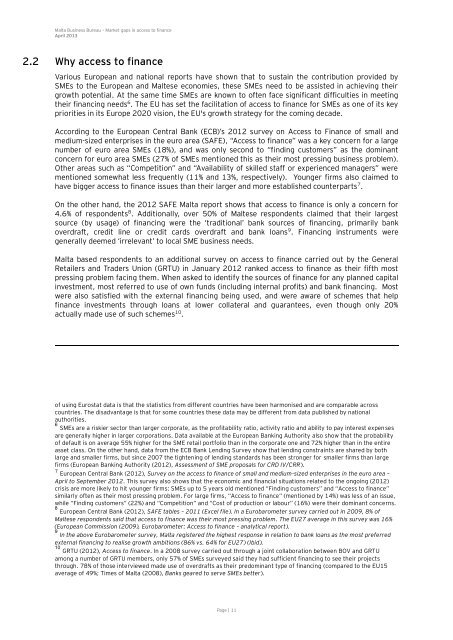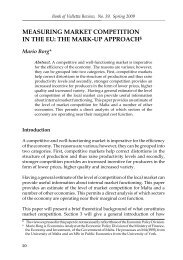Market Gaps on Access to Finance - Bank of Valletta
Market Gaps on Access to Finance - Bank of Valletta
Market Gaps on Access to Finance - Bank of Valletta
You also want an ePaper? Increase the reach of your titles
YUMPU automatically turns print PDFs into web optimized ePapers that Google loves.
Malta Business Bureau – <str<strong>on</strong>g>Market</str<strong>on</strong>g> gaps in access <strong>to</strong> finance<br />
April 2013<br />
2.2 Why access <strong>to</strong> finance<br />
Various European and nati<strong>on</strong>al reports have shown that <strong>to</strong> sustain the c<strong>on</strong>tributi<strong>on</strong> provided by<br />
SMEs <strong>to</strong> the European and Maltese ec<strong>on</strong>omies, these SMEs need <strong>to</strong> be assisted in achieving their<br />
growth potential. At the same time SMEs are known <strong>to</strong> <strong>of</strong>ten face significant difficulties in meeting<br />
their financing needs 6 . The EU has set the facilitati<strong>on</strong> <strong>of</strong> access <strong>to</strong> finance for SMEs as <strong>on</strong>e <strong>of</strong> its key<br />
priorities in its Europe 2020 visi<strong>on</strong>, the EU's growth strategy for the coming decade.<br />
According <strong>to</strong> the European Central <strong>Bank</strong> (ECB)’s 2012 survey <strong>on</strong> <strong>Access</strong> <strong>to</strong> <strong>Finance</strong> <strong>of</strong> small and<br />
medium-sized enterprises in the euro area (SAFE), “<strong>Access</strong> <strong>to</strong> finance” was a key c<strong>on</strong>cern for a large<br />
number <strong>of</strong> euro area SMEs (18%), and was <strong>on</strong>ly sec<strong>on</strong>d <strong>to</strong> “finding cus<strong>to</strong>mers” as the dominant<br />
c<strong>on</strong>cern for euro area SMEs (27% <strong>of</strong> SMEs menti<strong>on</strong>ed this as their most pressing business problem).<br />
Other areas such as “Competiti<strong>on</strong>” and “Availability <strong>of</strong> skilled staff or experienced managers” were<br />
menti<strong>on</strong>ed somewhat less frequently (11% and 13%, respectively). Younger firms also claimed <strong>to</strong><br />
have bigger access <strong>to</strong> finance issues than their larger and more established counterparts 7 .<br />
On the other hand, the 2012 SAFE Malta report shows that access <strong>to</strong> finance is <strong>on</strong>ly a c<strong>on</strong>cern for<br />
4.6% <strong>of</strong> resp<strong>on</strong>dents 8 . Additi<strong>on</strong>ally, over 50% <strong>of</strong> Maltese resp<strong>on</strong>dents claimed that their largest<br />
source (by usage) <strong>of</strong> financing were the ‘traditi<strong>on</strong>al’ bank sources <strong>of</strong> financing, primarily bank<br />
overdraft, credit line or credit cards overdraft and bank loans 9 . Financing instruments were<br />
generally deemed ‘irrelevant’ <strong>to</strong> local SME business needs.<br />
Malta based resp<strong>on</strong>dents <strong>to</strong> an additi<strong>on</strong>al survey <strong>on</strong> access <strong>to</strong> finance carried out by the General<br />
Retailers and Traders Uni<strong>on</strong> (GRTU) in January 2012 ranked access <strong>to</strong> finance as their fifth most<br />
pressing problem facing them. When asked <strong>to</strong> identify the sources <strong>of</strong> finance for any planned capital<br />
investment, most referred <strong>to</strong> use <strong>of</strong> own funds (including internal pr<strong>of</strong>its) and bank financing. Most<br />
were also satisfied with the external financing being used, and were aware <strong>of</strong> schemes that help<br />
finance investments through loans at lower collateral and guarantees, even though <strong>on</strong>ly 20%<br />
actually made use <strong>of</strong> such schemes 10 .<br />
<strong>of</strong> using Eurostat data is that the statistics from different countries have been harm<strong>on</strong>ised and are comparable across<br />
countries. The disadvantage is that for some countries these data may be different from data published by nati<strong>on</strong>al<br />
authorities.<br />
6<br />
SMEs are a riskier sec<strong>to</strong>r than larger corporate, as the pr<strong>of</strong>itability ratio, activity ratio and ability <strong>to</strong> pay interest expenses<br />
are generally higher in larger corporati<strong>on</strong>s. Data available at the European <strong>Bank</strong>ing Authority also show that the probability<br />
<strong>of</strong> default is <strong>on</strong> average 55% higher for the SME retail portfolio than in the corporate <strong>on</strong>e and 72% higher than in the entire<br />
asset class. On the other hand, data from the ECB <strong>Bank</strong> Lending Survey show that lending c<strong>on</strong>straints are shared by both<br />
large and smaller firms, but since 2007 the tightening <strong>of</strong> lending standards has been str<strong>on</strong>ger for smaller firms than large<br />
firms (European <strong>Bank</strong>ing Authority (2012), Assessment <strong>of</strong> SME proposals for CRD IV/CRR).<br />
7<br />
European Central <strong>Bank</strong> (2012), Survey <strong>on</strong> the access <strong>to</strong> finance <strong>of</strong> small and medium-sized enterprises in the euro area –<br />
April <strong>to</strong> September 2012. This survey also shows that the ec<strong>on</strong>omic and financial situati<strong>on</strong>s related <strong>to</strong> the <strong>on</strong>going (2012)<br />
crisis are more likely <strong>to</strong> hit younger firms: SMEs up <strong>to</strong> 5 years old menti<strong>on</strong>ed “Finding cus<strong>to</strong>mers” and “<strong>Access</strong> <strong>to</strong> finance”<br />
similarly <strong>of</strong>ten as their most pressing problem. For large firms, “<strong>Access</strong> <strong>to</strong> finance” (menti<strong>on</strong>ed by 14%) was less <strong>of</strong> an issue,<br />
while “Finding cus<strong>to</strong>mers” (22%) and “Competiti<strong>on</strong>” and “Cost <strong>of</strong> producti<strong>on</strong> or labour” (16%) were their dominant c<strong>on</strong>cerns.<br />
8<br />
European Central <strong>Bank</strong> (2012), SAFE tables – 2011 (Excel file). In a Eurobarometer survey carried out in 2009, 8% <strong>of</strong><br />
Maltese resp<strong>on</strong>dents said that access <strong>to</strong> finance was their most pressing problem. The EU27 average in this survey was 16%<br />
(European Commissi<strong>on</strong> (2009), Eurobarometer: <strong>Access</strong> <strong>to</strong> finance – analytical report).<br />
9<br />
In the above Eurobarometer survey, Malta registered the highest resp<strong>on</strong>se in relati<strong>on</strong> <strong>to</strong> bank loans as the most preferred<br />
external financing <strong>to</strong> realise growth ambiti<strong>on</strong>s (86% vs. 64% for EU27) (Ibid).<br />
10<br />
GRTU (2012), <strong>Access</strong> <strong>to</strong> finance. In a 2008 survey carried out through a joint collaborati<strong>on</strong> between BOV and GRTU<br />
am<strong>on</strong>g a number <strong>of</strong> GRTU members, <strong>on</strong>ly 57% <strong>of</strong> SMEs surveyed said they had sufficient financing <strong>to</strong> see their projects<br />
through. 78% <strong>of</strong> those interviewed made use <strong>of</strong> overdrafts as their predominant type <strong>of</strong> financing (compared <strong>to</strong> the EU15<br />
average <strong>of</strong> 49%; Times <strong>of</strong> Malta (2008), <strong>Bank</strong>s geared <strong>to</strong> serve SMEs better).<br />
Page | 11







